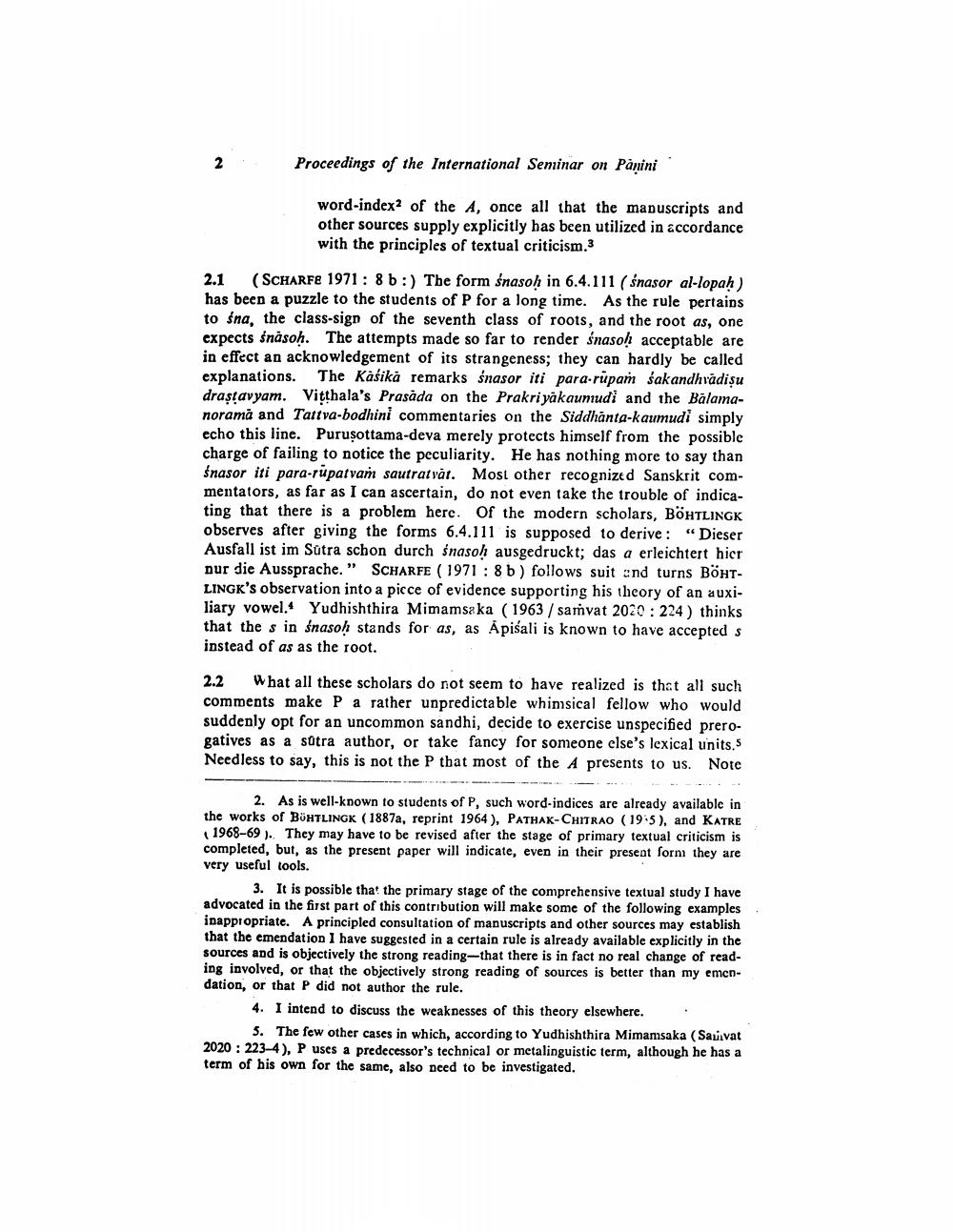________________
2
Proceedings of the International Seminar on Panini
word-index2 of the A, once all that the manuscripts and other sources supply explicitly has been utilized in accordance with the principles of textual criticism.3
2.1 (SCHARFE 1971: 8b :) The form śnasoh in 6.4.111 (śnasor al-lopah) has been a puzzle to the students of P for a long time. As the rule pertains to śna, the class-sign of the seventh class of roots, and the root as, one expects śnásoh. The attempts made so far to render śnasoh acceptable are in effect an acknowledgement of its strangeness; they can hardly be called explanations. The Kašika remarks śnasor iti para-rupan sakandhradişu drastavyam. Vitthala's Prasada on the Prakri yakaumudi and the Balamanorama and Tattva-bodhini commentaries on the Siddhanta-kaumudi simply echo this line. Purusottama-deva merely protects himself from the possible charge of failing to notice the peculiarity. He has nothing more to say than śnasor iti para-rupatvam sautrat vat. Most other recognized Sanskrit commentators, as far as I can ascertain, do not even take the trouble of indicating that there is a problem here. Of the modern scholars, BÖHTLINGK observes after giving the forms 6.4.111 is supposed to derive: “Dieser Ausfall ist im Sutra schon durch śnasoh ausgedruckt; das a erleichtert hier nur die Aussprache.” SCHARFE ( 1971 : 8 b) follows suit and turns BÖHTLINGK's observation into a picce of evidence supporting his theory of an auxiliary vowel.* Yudhishthira Mimamsaka (1963/ saṁvat 2020: 224) thinks that the sin snasoh stands for as, as Apisali is known to have accepted s instead of as as the root.
2.2 What all these scholars do not seem to have realized is that all such comments make P a rather unpredictable whimsical fellow who would suddenly opt for an uncommon sandhi, decide to exercise unspecified prerogatives as a sutra author, or take fancy for someone else's lexical units.5 Needless to say, this is not the P that most of the A presents to us. Note
2. As is well-known to students of P, such word-indices are already available in the works of BÜHTLINGK (1887a, reprint 1964), PATHAK-CHITRAO (195), and KATRE
1968-69 ). They may have to be revised after the stage of primary textual criticism is completed, but, as the present paper will indicate, even in their present form they are very useful tools.
3. It is possible that the primary stage of the comprehensive textual study I have advocated in the first part of this contribution will make some of the following examples inappropriate. A principled consultation of manuscripts and other sources may establish that the emendation I have suggested in a certain rule is already available explicitly in the sources and is objectively the strong reading-that there is in fact no real change of reading involved, or that the objectively strong reading of sources is better than my emendation, or that P did not author the rule.
4. I intend to discuss the weaknesses of this theory elsewhere.
3. The few other cases in which, according to Yudhishthira Mimamsaka (Sauvat 2020 : 223-4), Puses a predecessor's technical or metalinguistic term, although he has a term of his own for the same, also need to be investigated.




